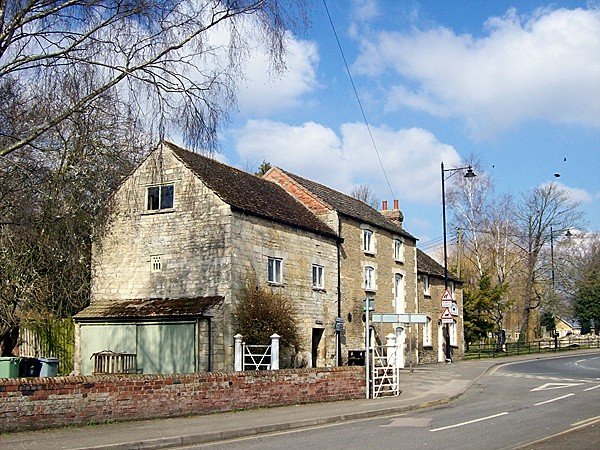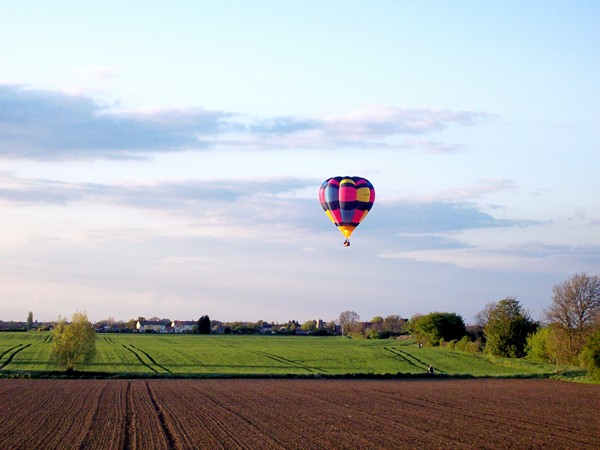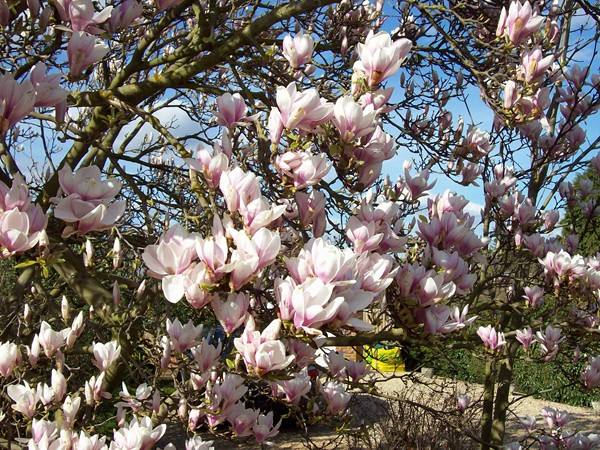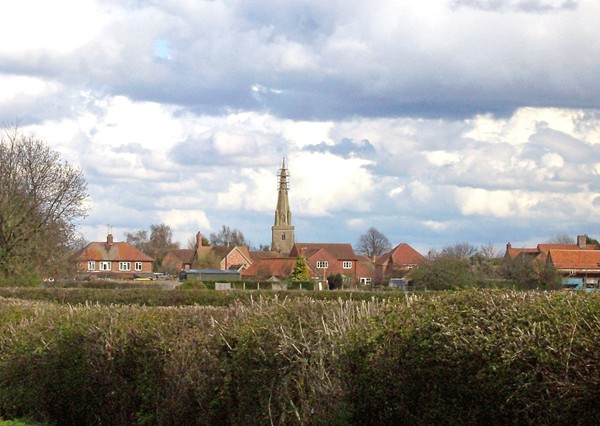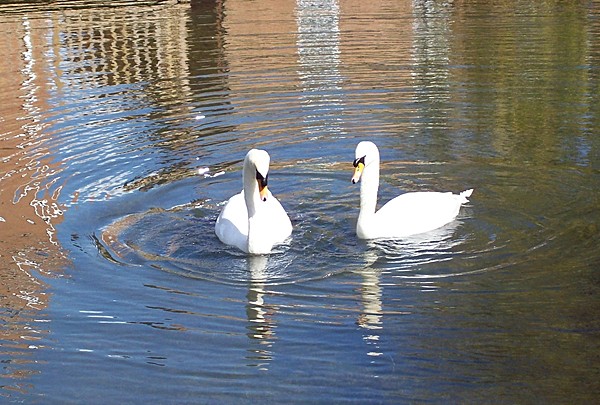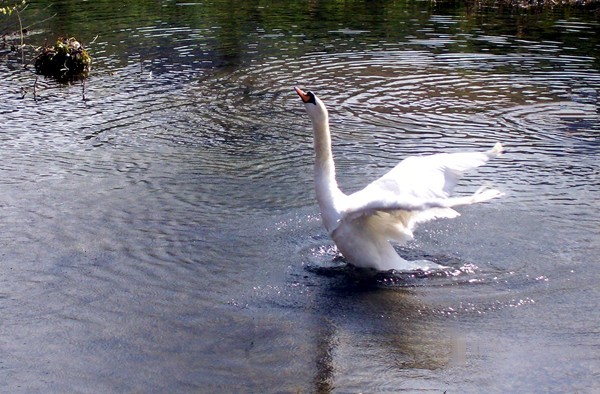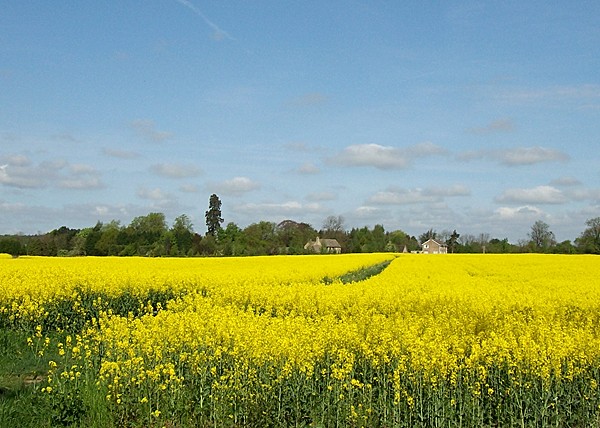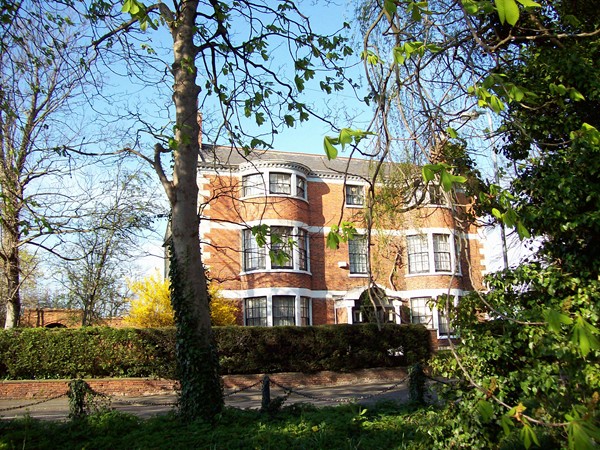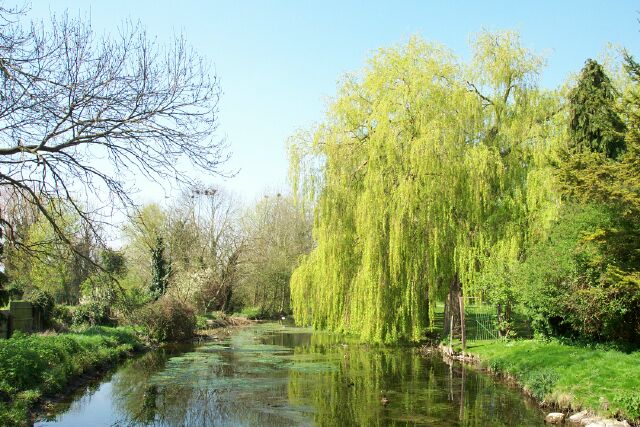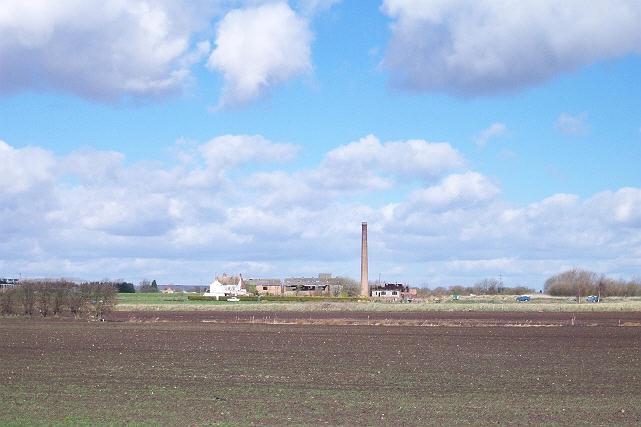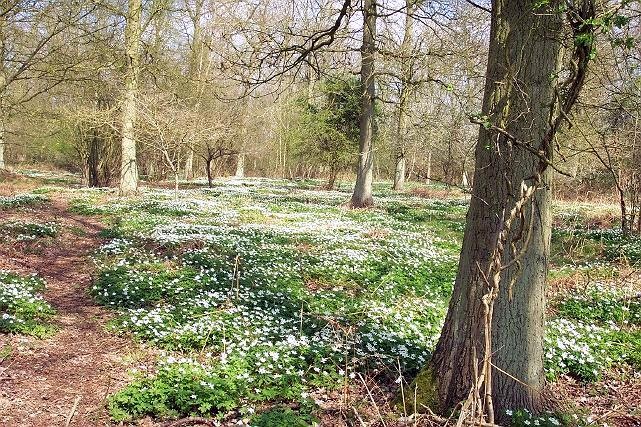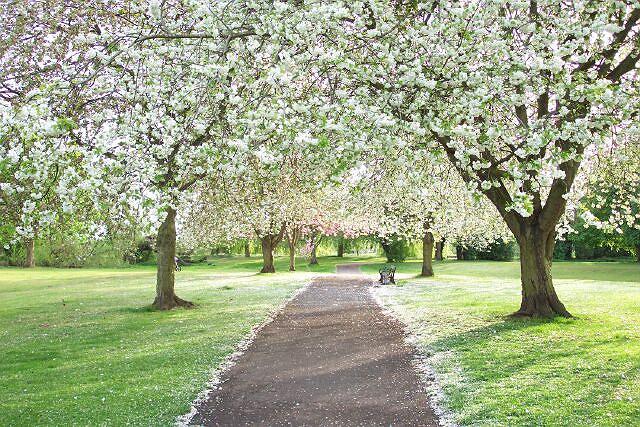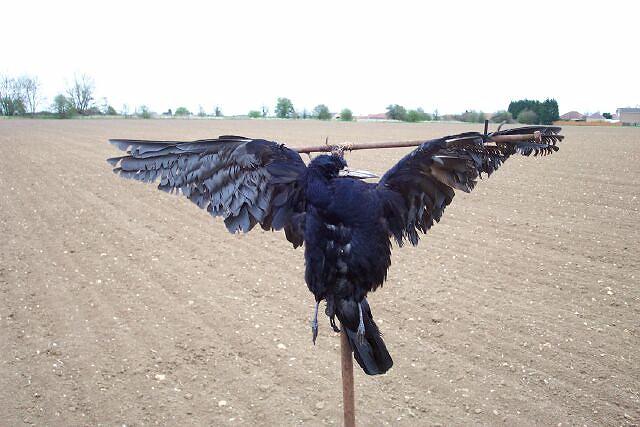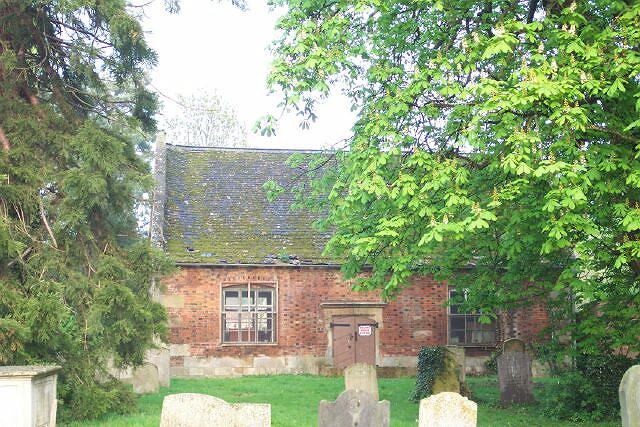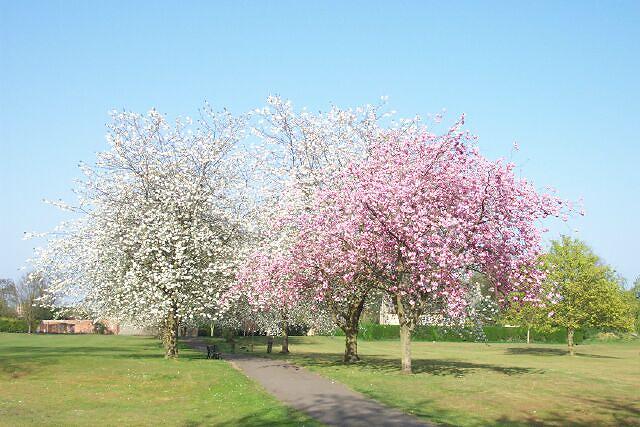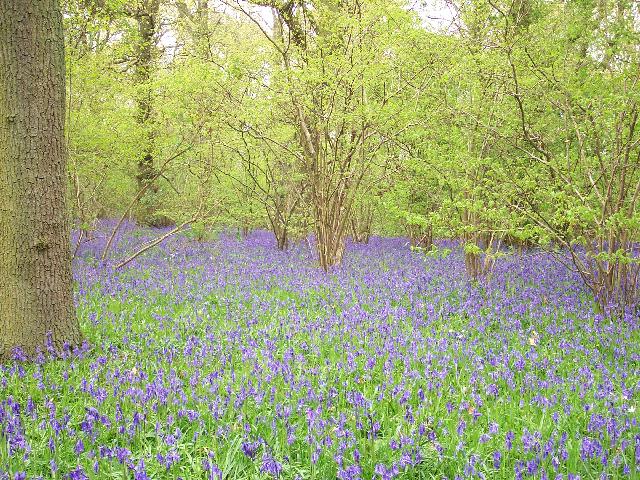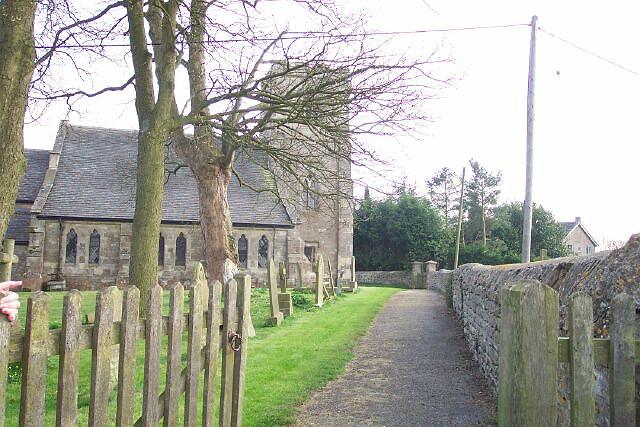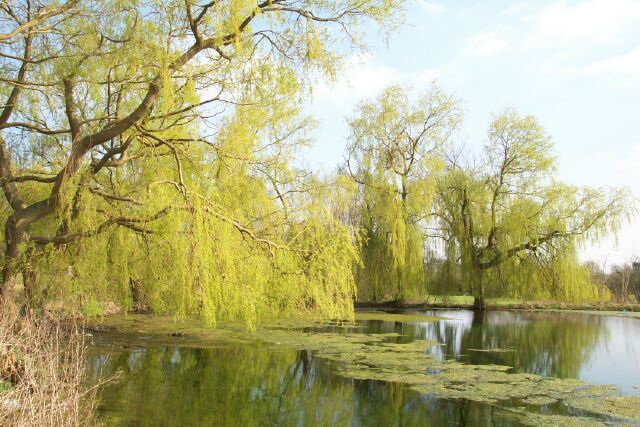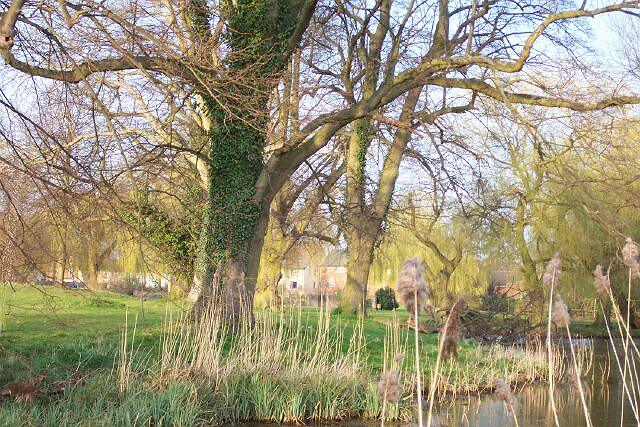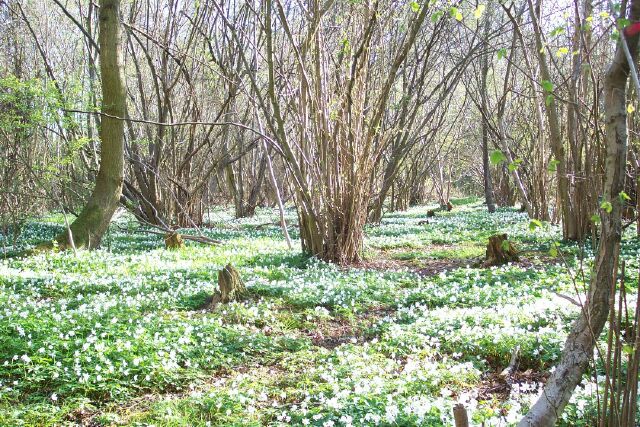|
April
Sunday 26th April 2015: Ornamental trees bring a touch of colour to the urban landscape each spring such as this flowering cherry in Queen’s Road, one of the streets established in 1953, the year Queen Elizabeth II was crowned, and so the name reflected this national celebration.
Thursday 25th April 2013: This beautiful spot on the Bourne Eau behind Baldock’s Mill in South Street has recently been enhanced by Bourne United Charities who have strengthened the bank and re-grassed the surrounding area which has also been planted with daffodil bulbs that are now in bloom. The ancient palisade railings which run along the pavement are also being given a fresh coat of paint and so the entire area will be looking good for the annual best kept town competition which will shortly be getting underway. In the meantime, with sunnier days ahead, this is the right time to enjoy a walk to see the river at its most attractive for many years.
Saturday 13th April 2013: The first solar farm for the Bourne area has been completed and another is in the pipeline which means that the familiar fenland landscape is about to change. Instead of the flat acres of farmland devoted to arable crops which have been the distinguishing feature for centuries past, large areas will soon be devoted to innumerable glass panels tilted towards the sun to collect its energy for the National Grid and so provide electricity for our homes and businesses. This area of England is perfectly suited for such projects because of the wide expanse of open skies and so we are certain to be having even more of these installations in the years to come.
Wednesday 3rd April 2013: The Domesday Book of 1086 records that there were three water mills in Bourne but only one remains and that can be seen standing in a commanding position alongside the Bourne Eau at the entrance to the town in South Street. The present mill dates from 1800 but stopped working in 1924 when the water wheel collapsed and after various uses it was converted by the Civic Society for its present role as the town’s Heritage Centre and is now Grade II listed as being of architectural and historic interest. By tradition, its name is derived from the last miller, Frederick Baldock, and a visit here is the starting point for anyone who wants to know about our history because the building is crammed with displays and exhibitions featuring Bourne and its people in past times.
Sunday 26th April 2009: The wide open skies in the fens around Bourne make this excellent countryside for hot air balloons which are to be seen on those occasions when the weather is right for a flight, still air and not a breath of wind, usually in the early morning or late evening. There is a field at Dyke village often used as a take-off point and the bags can be seen slowly inflating and then rising above the cottages and soon the multi-coloured balloons are soaring above the fields and houses. Sometimes, you can hear the sudden roar of the heated air being released to keep it afloat as they glide silently overhead and see the pilot and his passengers in the gondola slung underneath, often waving as they pass.
Thursday 23rd April 2009: We made our pilgrimage to Dole Wood today to find the annual display of bluebells the best we have seen for many years. This is truly one of the delights of springtime and the delicate scent of the blooms wafted down along the woodland path as we walked. Apart from a lone photographer, an old gentlemen carrying expensive equipment far too heavy and cumbersome for him, we had the wood to ourselves and the air was full of birdsong as we walked round, finding masses of bluebells in every glade as we passed, returning home with a satisfying feeling that despite the doom and gloom we are hearing every day, all is well with the world.
Saturday 4th April 2009: The front gardens along Mill Drove were planted with a variety of trees and shrubs when the road was developed thirty years ago and in one of them is a magnificent magnolia that flowers each year to provide a glorious welcome for passers-by, especially on sunny days. This tree is a comparatively rare sight in England, although now becoming more common, and usually confined to the United States, having originated in the Caribbean where it was first identified in 1703 by a Charles Plumier who named it after the French botanist Pierre Magnol. The magnolia is an ancient species, having evolved before bees appeared and the flowers are encouraged to pollinate by beetles with the result that the flowers are far tougher than they look but are a sheer delight on an early spring day as they are coming into bloom.
Friday 11th April 2008: Scaffolding has appeared on the top section of the slender and distinctive spire of the village church at Haconby, three miles north of Bourne, one of the landmarks in the South Lincolnshire countryside. A crack was discovered in the stonework and last February's earthquake which created so much alarm in the area has been blamed for causing the damage. The building has withstood the elements for the past five centuries but now needs repair work which will cost at least £25,000 and both the church and the surrounding graveyard have been closed as a safety precaution in case masonry is dislodged and tumbles down in high winds.
Sunday 6th April 2008: A Sunday morning walk along the banks of the Bourne Eau is always rewarding especially if the mute swans that inhabit this waterway are around, as they were today. It is a most relaxing pastime to watch them paddling silently to and fro, their long necks occasionally ducking underneath the water for a tasty morsel, and if you have patience and stay around long enough, you will catch them preening themselves in the spring sunshine, a rare occurrence but well worth the wait. I managed to capture this shot on the river behind Eastgate at the point where it joins the Car Dyke but unfortunately both are neglected and overgrown and rubbish remains a constant hazard to these stately birds and other wildlife.
Thursday 26th April 2007: Crops of oil seed can be seen in abundance around Bourne at this time of the year, huge swathes of yellow blossom stretching to the horizon and beyond. Some believe that this plant is out of place in a traditional English landscape but it has in fact been with us for a very long time, notably during the 17th century when the oil it produced was used by Dutch engineers who drained the fens to lubricate their pumps. In recent years, the acreage has increased to meet the demand for an edible oil as a home-grown alternative to groundnuts and soya. We found this crop on either side of the public footpath to Cawthorpe, a mile north of Bourne, and although some say it causes hay fever, it really is a startling sight.
Sunday 8th April 2007: Eastgate is one of the more secluded places in town and on Sunday afternoons it is probably the quietest. Nothing stirs and so this is the time to walk and explore and seek out unusual views such as this shot of Eastgate House, taken from the southern bank of the Bourne Eau which runs alongside the street until it reaches the fen at the far end. This was the lifetime home of Raymond Mays, the international motor racing driver and founder of the BRM, and the property dates back to the late 18th century when it was built entirely of stone. The elegant red brick frontage with ashlar quoins that we see today, designed in the Regency style, was added later and on days such as this, it glows in the late afternoon sun and reflects the splendour of its past owner whose lifestyle attracted the rich and the famous who came to stay.
Thursday 28th April 2005: There are many sections of the Bourne Eau that few people ever see because they are hidden from general view, such as here behind Baldock's Mill in South Street. You need to leave the road and take the public path that leads off to the left of the mill, under the archway, and although the going is not easy, especially in wet weather, because that path is not properly maintained by the owners, it is a worthwhile excursion with wildlife in abundance and, during the later months of the year, you might even catch sight of a kingfisher. It is here more than anywhere else in Bourne that you will notice the changing of the seasons because the weeping willows are taking on their glorious coat of emerald green and the water is full of ducks and moorhens accompanied by their young. With more tender loving care, this place could become one of the town's beauty spots but year after year it is left to waste away and the neglect is now becoming apparent.
Friday 23rd April 2004: One of the few landmarks in the flat countryside around Bourne is this tall chimney at the Slipe in South Fen, the relic of a former industry that was part of the town's prosperity in past times. It was owned by the Mays Chemical Manure Company Ltd, once a big employer which had its headquarters in Cherryholt Road, and used for the processing of hooves and horns from fallen stock such as horses, cattle and sheep, that were turned into glue. It was known locally as "the Bovril factory" because of the pungent odour it produced and frequently wafted over the town whenever an east wind was blowing in from the fen. The firm closed down 25 years ago because of economic conditions and changing patterns of trade and since then the old glue factory has been standing empty. It was used for a time as a practice location for the local fire brigade but is now badly neglected and dilapidated and awaiting a buyer although the sight of the chimney on the skyline is a reminder of the prominent part it once played in the commercial life of the town.
Monday 12th April 2004: We woke to a gloriously fine day and the woods beckoned, despite this also being Easter Monday when the woodland paths were likely to be busy, if not crowded, and so we found ourselves exchanging pleasantries with a multitude of people during our walk. My diary noted that the wood anemones would be in bloom and although small clumps can be seen almost everywhere, we found them in profusion in the quiet glades away from the more popular tracks, wide swathes of small white delicate flowers nodding gently in the light breeze on this warm spring morning, and I was reminded of John Clare's evocation of this fragile flower that appears in our countryside at this time of year: What
pretty, drooping weeping flowers they are
Sunday 27th April 2003: The cherry blossom does not stay long in the Wellhead Gardens and towards the end of April, the petals start to fall. They float down from the branches like snowflakes in winter, a reminder of the fable of an Icelandic princess who married a Portuguese prince and went to live in his country but missed the sight of falling snow and so he planted an avenue of cherry trees to please her because each year when their blossoms fell, they would simulate the scene she knew so well. There was once a predominance of pink cherry blossom trees here but several have been replaced in recent years and so now we have mostly white but still beautiful enough to enjoy on a spring evening although, despite its beauty at this season of the year, the gardens are strangely quiet and I am surprised that more people do not visit.
Sunday 6th April 2003: The sight of this photograph will offend many people yet it illustrates the belief many farmers have that a dead crow will keep others away and so this one was shot and publicly displayed in the middle of the field as a warning to others. It may sound unbelievable in this modern age yet I saw this happen because the field is outside my study window from where I can observe everything that happens and I went down later and took this picture. There were other birds, similarly killed and placed in vantage points around the field, and when I contacted the Royal Society for the Protection of Birds, I was told that although farmers are allowed to shoot birds that are a serious threat to agriculture, the staking out of carcasses is an ancient practice leftover from bygone days but one that is totally ineffective.
Thursday 24th April 2003: We went down to the churchyard in Bourne this evening, having heard that the Old Grammar School is under threat, and sure enough, we found a notice in bold red type nailed to the door saying "Building Unsafe - Keep Out". Despite its historic significance to the town, this property has been badly neglected in recent years and we are now reaping the results with crumbling brickwork and a leaking roof that will take £20,000 to put right. The school was a gift to the town in the 17th century and helped pioneer universal education in this part of Lincolnshire but there is also evidence that it may have been built on the site of a much older establishment dating back to monastic times in the 14th century and so there is every chance that the scholar Robert Manning may have taught here. Any suggestion that this building should be destined for further neglect and left to fall down will weigh heavily on the social conscience of this town for many years to come. The money will not be readily available and it will need a tremendous effort to raise but this is the task of those appointed to safeguard this building and we hope they are up to the challenge.
Thursday 23rd April 2003: The pink and white blossom on the ornamental cherry trees that line the main footpath through the Wellhead Gardens is one of the main attractions of springtime in Bourne. These trees are such a delight that we go there two and three times a week while they are in flower and the air is redolent with their scent, especially during the late afternoon. Unfortunately, several of these trees have been lost to us in recent years and whereas the walk was under a predominantly pink canopy in years past, today it is mainly white. This also used to be the perfect spot to sit and savour the scene but several of the public seats alongside the path have been removed by Bourne United Charities who own and administer these gardens, and only the metal supports that were sawn through to facilitate their removal remain, protruding through the concrete base. They were taken away because youngsters congregated here after dark and were deemed by the trustees to be a nuisance but instead of seeking police assistance to move on the offenders, they ill-advisedly decided to remove the seats, much to the inconvenience of those who do enjoy this place which is supposedly maintained for the public benefit.
Wednesday 16th April 2003: Sunshine and shadow add an air of magic and mystery to this woodland scene, captured this afternoon on the hottest day of the year so far with temperatures reaching 80 degrees F. But it was cool in the depths of Dole Wood, a favourite haunt at this time when the bluebells start to bloom, and today there was the added bonus of wood anemones still in flower because they have enjoyed such favourable weather since they first appeared a month ago.
Saturday 12th April 2003: I include this photograph as an example of the loyalty I enjoy from my wife Elke who accompanies me on all of my trips in search of new material which we found this afternoon when visiting the village of Swayfield, seven miles north east of Bourne. I was last here in 1998 when the churchyard was in a most untidy state but things have changed in the intervening years and it is now one of the most delightful examples of God's little acre in South Lincolnshire. The view I wanted to photograph was the entrance path with the gate open but it resisted stubbornly because it was set at an upward angle and repeatedly swung closed. The only way I could keep it in position was by asking my wife to hold it back while I took my picture yet keep out of shot, a difficult task because it was a heavy gate and needed some strength but after several attempts and much complaining from her about the effort required, I decided that I had captured the moment. Back home at the computer, I realised that I was mistaken and so here is the entrance to Swayfield church and a glimpse of my wife's left hand. A photographer's lot is not always an easy one.
Thursday 3rd April 2003: We return to St Peter's Pool day after day and I have photographed it so much that I think I can never take another but each time I find a fresh view, influenced by the season of the year and the light of the day. This afternoon, we found that the weeping willows had burst into leaf, giving them a golden green coat as they leaned over the water, and this time we looked at them while leaning on the iron railings bordering the path through the Wellhead Gardens and this gave me a new perspective on a familiar scene. Many people come here, often alone because they have few friends, and today we found an old lady, shrivelled with age and seeking company, yet knowing all about this place and the species of birds that live here. I watched her talking to my wife and it occurred to me that this pool must have been a meeting place for centuries and I wondered how many similar chance encounters had occurred here and how many lives had been enriched by a brief conversation at the water's edge.
Tuesday 1st April 2003: Although Bourne is an expanding town with many newcomers arriving and exploring the highways and byways, there are still one or two secluded spots where few people go and this is one of them. Surprisingly, this place is only a short distance from the busy town centre and yet it appears quiet and remote and a magnet for wildlife, with mallard and moorhen on the water and an occasional kingfisher dipping and diving among the reeds on the far bank. Even long time residents of the town would be hard put to identify the exact location but I took this photograph from the footpath that begins alongside Baldock's Mill and runs westward, with the old water cress beds on one side and the Wellhead Gardens on the other. The cottages that can be seen through the trees are those in South Street and the water is of course, the Bourne Eau just before it runs into the pool that feeds the mill race. Bourne has many such delights waiting for those who are prepared to seek them out, especially in springtime.
Saturday 27th April 2002: We find bluebells irresistible and email friends from around the world regularly ask for more views of this wondrous springtime flower that can be found growing in such profusion here in England at this time of the year. Bluebells are confined mainly to those parts of Western Europe that are exposed to the moist but mild Atlantic climate and are therefore distributed widely throughout the British Isles where they can be found in open glades in many deciduous woodlands and nowhere else in the world is this spectacle repeated. The previous picture was taken at Dole Wood, two miles south west of Bourne, which is little more than a spinney, but the photograph above was taken in Bourne Wood, a larger ancient forest covering 400 acres which also contains many bluebells, although harder to find because those places where they grow are off the beaten track and yet provide a delightful sight when you seek them out.
Saturday 20th April 2002: Spring is the highlight of our year and the bluebells in Dole Wood are a reminder that the season is well upon us and that more delights are to come. This small slice of woodland is little more than a copse set in the middle of the corn belt two miles south of Bourne but carefully managed as a nature reserve and although well off the beaten track, those who know of its existence make their annual pilgrimage to see the colourful display that appears each April to remind us that the future of our land is in our hands and we tamper with it at our peril. Bluebells (Endymion non-scriptus) are the sign of an ancient woodland and it is therefore reasonable to assume that this spinney of deciduous trees and woodland plants was once part of a large forest that was slowly cleared over the years, originally to supply timber for the ships of Queen Elizabeth I to fight the Spanish Armada in the 16th century and later to provide more land for England's burgeoning agricultural industry. Ironically, we no longer have need for such intensive farming production but there is no way that we can bring back the forests that filled the rural landscapes of yesteryear.
Wednesday 17th April 2002: Although early spring is the time for the wood anemones to take centre stage in Bourne Wood, there are patches of small or lesser celandine to be found growing on the fringes of this wonderful display, usually in those damp places that provide them with a perfect habitat, along the banks of the many streams that run through the forest and along the edges of the boggy areas that remain wet even in the driest of weather. The lesser celandine (Ranunculus ficaria) has many other names familiar to country folk, among them figwort, smallwort and pilewort, and its cheery, star-like blossoms light up the undergrowth even before winter is quite spent with its glossy foliage forming a dense carpet underneath. They are also fine weather flowers, closing before rain and even in fine weather they do not open before nine o'clock in the morning and by five o'clock in the afternoon, they will have closed for the night. We found this patch alongside the main track leading into Bourne Wood but there are many more to provide a burst of colour before the bluebells appear.
Wednesday 10th April 2002: We find the wood anemones irresistible and visit Bourne Wood frequently at this time just to seek them out. Our trip today was particularly worthwhile because we found them in profusion in this glade, surrounded by ancient oaks and well away from the main paths, and so our journey was worthwhile.
Monday 8th April 2002: The Bourne Eau is home to many varieties of water birds as it runs through the Wellhead Gardens near the town centre and among them are a large number of mallard and moorhen. They are less wary of humans than other birds and mingle easily with visitors, mainly because children are brought here by their parents to feed them with tit bits of bread and biscuits and youngsters can often be seen delving deep into their paper bags for tasty morsels while surrounded by a flock of ducks. A rarer occurrence is to see these birds breeding but this week I found a pair of moorhen that had built their bowl-like nest of sedge leaves and straw in the safety of the reeds, dense waterweed and branches of a weeping willow that brush the surface behind Baldock's Mill. The moorhen or common gallinule (Gallinula chloropus) has a red bill and black plumage with white under feathers and this pair was hidden away in a secret place busy rearing their young with the female sitting on half a dozen yellow speckled eggs to incubate them and the male shuttling to and fro bringing her food. A wonderful sight on a sunny April afternoon.
Saturday 6th April 2002: Wood anemones (Anemone nemorosa) are among the first of our spring flowers and we have known them to appear in Bourne Wood as early as March 14th although it is best to wait a few weeks to see them in profusion because they depend on the sunlight of early spring for flowering before the trees come into leaf. They are often found in ancient broad-leaved woodland sites such as this because of their poor colonising ability and this forest contains many hidden glades where they thrive year after year. This Saturday afternoon, a bright and sunny day but with a chill wind blowing, we walked the main path and soon found them carpeting the forest floor around the coppiced hazel, nodding gently as the wind rustled through the undergrowth although they always seem to find the most protected spots and come to no harm. These delicate many petalled flowers of white, tinged and veined with purple, are much associated with elves and wood nymphs and when seen swaying in a gentle breeze, it is not hard to imagine fairy dancers.
Tuesday 24th April 2001: This is a wonderful time to be out and about in the countryside to welcome the spring although it is less attractive than it was in years past and intensive farming is to blame. This is the East Glen River at Braceborough, four miles south of Bourne, with azure blue water and surrounding green fields but where have all the wild flowers gone? Half a century ago, the river bank would have been carpeted with spring blooms, yellow primroses, marsh marigolds and lesser celandines, but here they have become victims of an annual dose of agro-chemicals to boost yields and much of our countryside has been similarly affected. To find these flowers today you need to search for those out of the way places that have escaped the effects of herbicides and pesticides. Now we have another crisis on our hands with the foot and mouth epidemic and one of our most perceptive writers, A N Wilson, has suggested that because of the subsequent destruction of our livestock, we could be witnessing the final death throes of rural England and he gloomily forecasts: "This really is the end."
Saturday 14th April 2001: Our weather in Bourne these past few weeks has not been good with rain, wind and cold but the emergence of spring is unstoppable as the new season battles to show its face despite the elements. Here along the Bourne Eau in South Street, just a short step from the town centre, spring flowers adorn the banks, the weeping willows are bursting into leaf and pink cherry blossom is making its annual appearance. But signs of the inclement weather of past weeks are everywhere because many trees have lost branches during the winter gales and areas of the Wellhead Gardens nearby have been flooded. Nevertheless, there is beauty around for those who take the trouble to look and it reminds us that spring will appear, come what may.
Thursday 5th April 2001: Spring is the season of renewal and rebirth, the life cycle on which our religions are based, and here at St Peter's Pool in Bourne, the black swans that live at this once sacred spot produced four cygnets this year. These swans are handsome birds with dark, curly plumage, bright red bills and white wing feathers that show only in flight and are indigenous to Australia and Tasmania but these were raised in captivity by the Wildfowl Trust who gave them to the town in 1999 and so we are indebted to them for the pleasure they provide whenever we visit. Unfortunately, this is a cruel world and amidst all of the animal slaughter that we are currently experiencing in England now, one of the cygnets has been lost since I took my photograph, most likely to a predator for the newly born are always vulnerable, and we can only hope that the remaining three will survive.
Saturday 8th April 2000: There are many who want to see our countryside survive and I was reminded of such dedication a few days ago as I was driving home on the road between Edenham and Morton. This route includes a one mile stretch with wide grass verges on either side which are known as the Hanthorpe verges, a protected environment because they are rich in wild flowers including early purple orchids, cowslips, primroses and even false oxlips. But I spotted someone who seemed to be acting quite suspiciously. He was dressed in cycle riding kit with a baseball cap on his head and a mountain bike lay nearby and he was walking up and down and putting things into a large black plastic bag. I slowed down to take a closer look and it appeared that he was collecting something and in view of past experience I wondered if he was stealing plants but then I recognised him as Terry Barnatt who lives at Hanthorpe and is one of the leading lights in local conservation and was in fact collecting rubbish from the verges, a job he does regularly to keep them attractive, because he is the official warden for this site, appointed by the Lincolnshire Wildlife Trust of which he is also a council member. It is deplorable that rubbish should be deposited in such an isolated part of the countryside because those who stop are nature lovers and would not therefore drop anything and so all of the debris that he did find had been thrown from the windows of passing vehicles, newspapers, fast food cartons, sweet wrappers and plastic bottles. This is yet again an example of the anti-social habits of those who are quite prepared to ruin the appearance of our countryside rather than take their garbage home.
Saturday 29th April 2000: Wood anemones are among the earliest of our spring flowers and can be found in this part of South Lincolnshire in the hedgerows and upland meadows, along the banks of streams and on roadside verges. They always provide a grand display in Bourne Woods and this year they have arrived in the utmost profusion and the forest floor is carpeted in many places with their delicate and fragile blooms, the large numbers due no doubt to our mild winter. Like many woodland plants, the wood anemone makes use of the sunlight of early spring for flowering before the trees come into leaf and so their appearance will be a brief one and they will be gone by May.
Tuesday 27th April 1999: The narrow country roads around Bourne are at their most picturesque in the spring and it is best to drive very slowly to allow the landscape unfold before you. This view of Grimsthorpe Castle standing proudly on the far hillside across the valley appeared soon after leaving Elsthorpe and I stopped for some time to admire it.
Go to: Main Index Villages Index |


